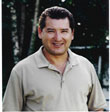 Before
you can begin a running program, you must understand some of the
concepts and principles of running.
Before
you can begin a running program, you must understand some of the
concepts and principles of running.
One of the concepts
of a running program is endurance. Endurance is how long you can
train the muscle. Your endurance depends on how much glycogen
is in that muscle before you start your training. If your muscle
can hold twice as much glycogen, you can train that muscle twice
as long. If your muscle can hold three times as much glycogen,
you can train that muscle three times as long. The only way you
can teach your body to hold more glycogen is through training
that muscle until it runs out of the stored glycogen supply. This
process is called depletion. After you eat, your glycogen supply
replenishes itself. Your muscle will then be able to store more
glycogen than it originally could.
You're asking yourself
which method of training is best for depletion? The long run depletes
stored glycogen; deplete this storage once a week with a long,
steady run at a comfortably hard pace. If you do too many hard,
or long days continuously, then the individual will not improve
(compensate). The body improves on easy and rest days (super compensation).
Training fast on hard days will not help the individual improve
if you do too many hard days back?to?back. A common mistake is
running fast, back?to?back days and working out hard on a daily
basis. Not all continuous runs are always fast, be specific, for
example: running one and half minutes per mile slower than your
personal performance in the 5K.
Coaching
Volume and Intensity
"Running on the Track"
One cycle consists of: run 2 laps, walk ½ lap
Number of cycles__________ per day
Start with young runners
with 3 to 4 cycles. Each runner has different abilities. Develop
and plan a program to meet the needs of each individual. Tell
the runner to start off on an easy jog. If you forget to tell
the runner the proper pace, the runner is confused and run too
fast and be sure to explain to start off easy and not to run fast.
After the runner finishes the workout, ask the runner if they
could do more, stay the same or do less cycles for the next day's
workout remember to adjust to fit the number of cycles to the
needs of the individual for the next day's workout. After each
running workout insert flexibility. Phase I may last 1-3 weeks.
A beginner may start in Phase II or III and bypass Phase I depending
on his/her development of endurance.
Phase
II
Run 1 mile continuously
without stopping for 5-6 days or run one mile 4 days and 2 miles
continuously 2 days. Remember, depending on the development of
the runner, Phase II may last 1-3 weeks or longer. Ask the runner
if they walked on the run; if walking on the run is still a problem
make adjustments. Do not advance to Phase III until the runner
can run continuously without stopping for a week or longer.
Period
Phase III
Run 2 miles continuously
for 4 days and one mile for 2 days or run 2 miles continuously
without stopping for 5-6 days. Phase III may last 1-3 weeks or
longer.
Phase
IV
Run 2 miles continuously
for 3 days and run 3 miles for 3 days in a week or run 3 miles
for 5-6 days. Phase VI may last 1-4 weeks. Be cautious to insert
competition, time trials or interval running as a general rule
your first priority is coaching (volume and intensity) continuous
running at 130-150 bpm. The next step is coaching intensity, running
continuous for 20-60 minutes and interval running for 4-8 minutes
at 150-174 bpm. When the beginner can run continuous and learn
to run with intensity efficiently then he or she can start in
the next period of training in the Preparation period.
Coaching
instructions for the beginner:
1. To stay in the phase
all week.
2. Don't change to different phases without the coach's instruction.
3. Always ask the coach for instructions.
4. Always tell the coach daily what phase and mileage you are
running.
5. After you finish your workout, ask the coach for further instructions.
6. Communicate to your coach every day. Check in and check out.
7. The body improves on rest days.
![]()




